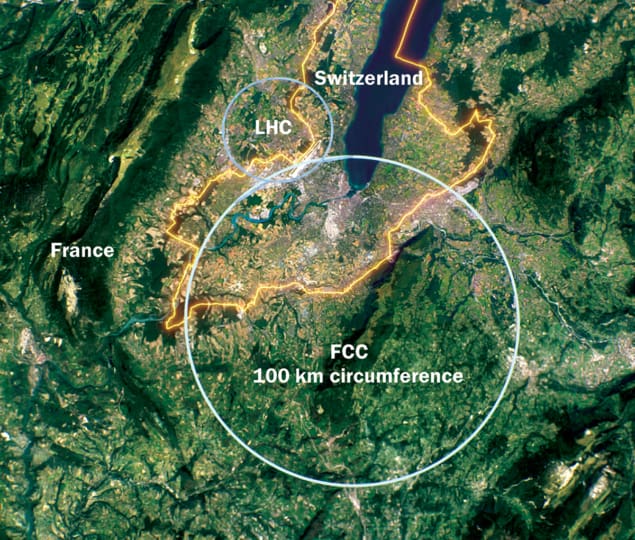
The carbon footprint of a future Higgs factory could vary by almost a factor of 100, depending on the chosen design and its location. That is the conclusion of an analysis by physicists in Europe who have studied the potential successors to CERN’s Large Hadron Collider (LHC). The researchers conclude that the proposed Future Circular Collider (FCC), which would be based at CERN and linked to the LHC, would be the most environmentally friendly as it would consume less energy and produce lower carbon emissions per Higgs boson produced than competing designs (arXiv:2208.10466).
Following the discovery of the Higgs boson in 2012 at the LHC, particle physicists are planning to build a more powerful particle collider. The future machine, known as a Higgs factory, would smash electrons with positrons to allow more detailed investigation of the properties of the Higgs boson and other particles.
There are currently five proposals for a high-energy positron–electron collider, with the International Linear Collider (ILC) in Japan, the Cool Copper Collider (C3) in the US and the Compact Linear Collider at CERN all based on linear accelerators. The FCC and the China Electron Positron Collider (CEPC) in China, meanwhile, are circular colliders.
There are various arguments around the physics opportunities of the different collider designs, but CERN particle physicist Patrick Janot and his colleague Alain Blondel argue that due to the high energy consumption of any future collider, the significant environmental impact of the designs should also be considered.
“We are proposing that future high-energy physics projects include not only the cost and performance of the collider, but also its carbon footprint per physics outcome, and to use these data in the design and the choice of the ‘best’ collider,” Janot told Physics World. Researchers analyse carbon footprint of planned neutrino experiment
In their analysis, the duo found that the FCC was the most energy-efficient design, consuming 3 MWh of electricity for each Higgs boson it produced. The next best was the CEPC at 4.1 MWh per Higgs boson, while the most energy intensive design is the C3 (18 MWh/Higgs boson).
The researchers then examined the carbon intensity of electricity production in the different countries hoping to host a future high-energy collider. The FCC was again best, emitting 0.17 tonnes of CO2 equivalents (t CO2 eq.) per Higgs boson produced. The ILC, meanwhile, would produce around 50 times more CO2 equivalents (9.4 t CO2 eq. per Higgs boson). The FCC’s low emissions are in part because around 80% of energy produced in France is from nuclear plants, and therefore mostly carbon-free.
The team found that the carbon footprint of the FCC could be further improved if the design increased the number of interaction points from two to four. In this scenario each Higgs boson produced would consume 1.8 MWh of energy and emit 0.1 tonnes of CO2 equivalents.
Janot adds that the analysis focuses on the environmental impact of the physics outcome and the energy consumption of operating the proposed Higgs factory. He adds that it is part of a much larger feasibility study on the FCC, which will cover among other things, the environmental impact of different phases of the project. This will include, for instance, tunnel building and the installation and operation of the colliders. But he points out that “the energy consumption during operation is the largest contributor to the carbon footprint of a high-energy collider”.
Other factors
Physicist Kumiko Kotera from Sorbonne University in Paris, who has carried out an analysis of the potential carbon footprint of the Giant Array for Neutrino Detection (GRAND) project, told Physics World that energy consumption and carbon emissions per Higgs boson is a sensible comparison. Kotera explained, however, that to produce a more accurate carbon footprint analysis in addition to the energy consumption of the collider, energy consumption related to data analysis and simulations, and other linked digital technologies, such as data storage, also needs to be considered. CERN approves further work on Future Circular Collider – but delays final decision
Kotera adds that a full analysis also needs to take into account international travel by its members, although she suspects this would be less energy hungry than collider operations and digital technologies.
Janot agrees that more can be done, adding that CERN is working on ways to reduce its carbon footprint. These include, among other things, energy recovery, managing electricity consumption to maximise the use of low-carbon sources as well as ways to develop international collaborations that minimise travel.



